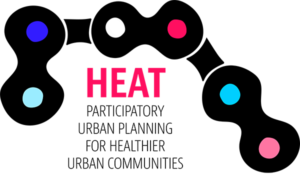HEAT project: infographics, animations and other results


From 2018-2021, the Institute of Baltic Studies was a partner in the HEAT project funded by Interreg Central Baltic. The aim of the project was to enhance participatory urban planning for healthier urban communities.
In the project, IBS’ main task was developing an interactive solution that would help disseminate the main lessons and results of the project and increase their uptake among city planners. Additionally, IBS worked closely with the other local partner, Tartu City Government in planning and organizing awareness raising campaigns, stakeholder meetings, etc.
In the project, three short animations were commissioned that all focus on a different aspect of city planning: planning campaigns, organizing digital events and investing in walking and cycling. Based on every animation, an infographic poster was also prepared, and two additional posters were created to illustrate the e-book. Both the e-book and the infographic posters were translated to Estonian as well.
Animations can be viewed on the HEAT project website or on the YouTube channel of IBS: https://www.youtube.com/watch?v=p8vi1LfHdAE&list=PLntLFlNUNj1OTXdq6boybGLhuqSmHRWp2&ab_channel=BaltiUuringuteInstituut
The Estonian language infographic posters and the e-book can be downloaded from the IBS website (see right-hand menu) or from the HEAT project website: https://www.heatproject.eu/results/results-for-participatory-urban-planning/
Based on HEAT tool calculation and public idea gathering, Tartu City Government also procured several important analyses and documents that help the city to better plan the development of walking and cycling infrastructure. They can be viewed on the HEAT project website (https://www.heatproject.eu/results/integrated-urban-plans/) or on Tartu City website:
- Tartu walking and cycling networks. Part I: network (https://www.tartu.ee/et/uurimused/tartu-jalgsi-ja-rattaga-liikumise-vorgustikud-i-osa-vorgustik)
- Tartu walking and cycling networks. Part II: intersections (https://www.tartu.ee/et/uurimused/tartu-jalgsi-ja-rattaga-liikumise-vorgustikud-ii-osa-ristmikud)
The HEAT project also provided important input into modelling and analyzing the transport networks in Tartu City masterplan (https://www.tartu.ee/et/uurimused/tartu-linna-uldplaneeringu-transpordivorgustiku-modelleerimine-ja-analuus)